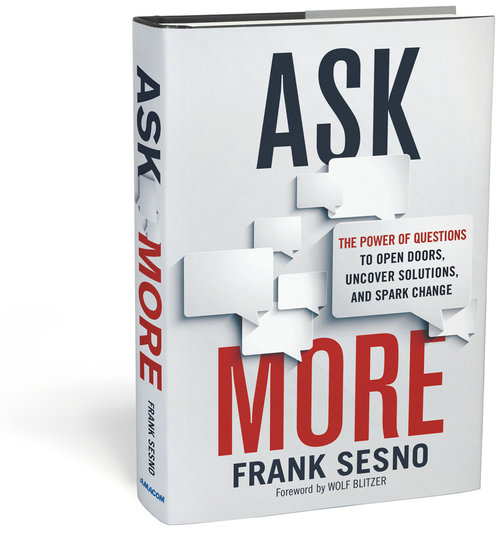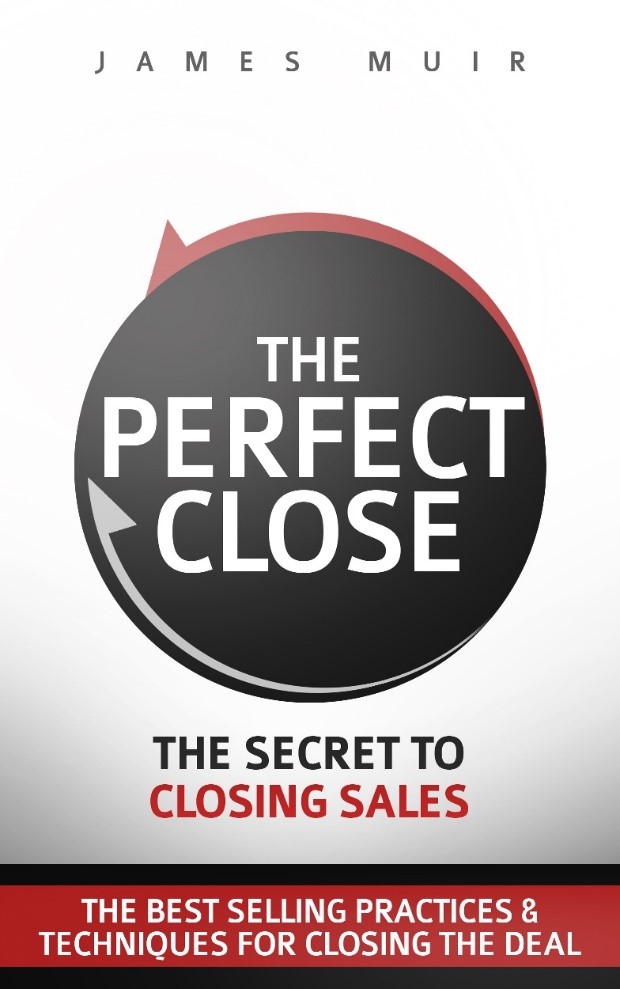If you could think of one change to make in your communication habits that would make you more influential, more interesting, and more well-liked, what would it be? The answer, according to Frank Sesno—and one which I strongly endorse—is to ask more questions. In his book, Ask More: The Power of Questions to Open Doors, Uncover Solutions and Spark Change, Sesno, a former CNN anchor, explains why questions are so powerful and how to ask them.
In this review, I will ask and answer four questions:
- Why should you ask more questions?
- Why read this book?
- What are some of the main lessons?
- How should you read the book?
Why ask more questions?
You probably don’t ask enough questions—so what? The big-picture answer, filtered through the lens of lean communication, is that you are producing less value and more waste than you should. Value is defined by the listener, and if you don’t know your listeners as well as you should, how can you express your points in ways that are most likely to resonate with them? Asking more questions helps you zero in on exactly what’s important to the other person. But even better, asking questions engages the other person so that together you both create more value and more memorable communication. I love this quote from the book: “People forget what they heard, but they remember almost everything they say.”
Why read this book?
There are many good books on questioning, written from the perspective of sales, psychology, management[1], etc. but this is the first one (that I’ve read, at least) by a journalist, who by definition makes his living through the quality of his questions. Besides the credibility it adds to the book, Sesno’s professional expertise adds two other assets that make Ask More worth reading. First, he knows how to find other credible sources, so he is not just relying on what has worked for him, as so many experts do, and this brings a breadth and diversity of different situations and applications where questioning is helpful. of questioning applications. Second, he knows how to tell stories lucidly and concisely, so the book makes for pleasant and engaging reading.
What are some of the main lessons?
The book is organized into chapters that explain how to ask questions for different purposes, from solving problems to inspiring others, to sparking creative thinking, to building rapport. But regardless of your purpose in asking questions, some general principles come through. Probably the most important is that you should have a purpose and a plan for your questions. Your plan will help ensure that you don’t miss anything important, and your purpose will keep you on track when the person you’re interviewing inevitably throws you off your plan, whether accidentally or on purpose. Second is the importance of knowing how to listen to the answers and what to listen for—especially what is not being said. Third, by learning the basic structure of each specific questioning application, you can apply a reasonably repeatable process that will save you time and ensure you don’t miss anything.
How should you read the book?
If there is one improvement opportunity I would suggest for this book, it would be to go a bit lighter on the stories and heavier on the “how-to”. For example, in the chapter on empathetic questioning, as he introduces a man who got John Hinckley to open up through questions, do we really need to know the path of each of the six bullets John Hinckley fired? That’s why I would suggest that you begin reading the book at page 211, which begins the “Question Guide” section, where the basics of each major questioning task are laid out. Then, you can go back through the book and read the sections that you find most useful, and having the layout of each section in mind will make it easier to tease out the lessons from the stories and extraneous detail.
Despite that last quibble, Ask More is an important and worthwhile book. We can all benefit from improving the quantity and quality of the questions we ask, and I personally resolve to improve on that this year. So, let me end with one more question:
What are you waiting for?
[1] A few good examples: SPIN Selling and Question Based Selling for Sales; Leading with Questions, for leadership;
Humble Inquiry, for psychology.
Let’s be completely honest with ourselves: sometimes we give gifts to others at least as much to make ourselves look good as to make the recipient happy. For example, when you buy a bottle of wine to give to someone important, you want to get something they will enjoy, but you also want to show your good taste and sophistication.
It’s the same way with books: if there is someone you want to suck up to, maybe your boss’s boss or a prospective client, here are some book recommendations that will meet both goals. They will please the recipient and mark you as an especially discerning and intelligent person at the same time.
Thinking, Fast and Slow, by Daniel Kahneman. Kahneman is one our most important thinkers, who won the Nobel Prize in Economic Sciences for his work, even though he’s a psychologist. This book is both instructive and entertaining, and will help you understand the quirky workings of the human mind. If you’re unsure whether to give this book as a gift, think of what will happen if someone else does before you do.
Originals: How Non-Conformists Move the World, by Adam Grant. Grant is described as a top-rated teacher at Wharton, and this book shows why. There are several reasons you might not want to get this book for someone, the most important one being that it can be dangerous to be perceived as an original thinker, especially within a large organization.
Pre-Suasion, Robert Cialdini. This is the newest book by one of the acknowledged legends of the influence world. Honestly, I didn’t think it was as good as the book which he’s famous for: Influence: The Psychology of Persuasion, but giving it will make you look smart and up to date.
Superforecasting, Philip Tetlock. This book is full of practical ideas to improve your judgment and predictive ability.[1] Using the National Intelligence Council’s 7-point scale, I predict that you are almost certain to impress anyone you give this book to, especially if they think you’ve read it.
How to Fly a Horse: The Secret History of Creation, Invention, and Discovery, by Kevin Ashton. This book will fascinate and impress anyone who works in or with technology, and they might even find creative ways to thank you for it.
Thank You for Being Late: An Optimist’s Guide to Surviving in an Age of Accelerations, by Thomas Friedman. I’m breaking my own rule by recommending a book that I haven’t finished reading yet, but I didn’t want to be late in making this recommendation. If you’re concerned about the state of the world, Friedman will restore your optimism.
P.S. One of the best qualities of each of these books is that they are each so well-written that the recipient will actually read them. So, if you’re going to give one of these, it’s a good idea to buy a copy for yourself and read it!
[1] Although I have to admit I read it and still got the 2016 election wrong.
I don’t like to make predictions, especially about the future, but I predict that James Muir is a name you will be seeing more and more in the conversation about top sales experts. I’m basing that on his new book, The Perfect Close.
But first, let me say that the book’s title is a bait-and-switch, albeit a positive one. That’s because the two closing questions that Muir recommends are only introduced in Chapter 12, almost at the end of the book. The first eleven chapters are all about the approach that you should take before and during the sales call to put yourself into the best position for the close. But I think that’s the best way for presenting the material in this book. Muir tells you right up front that you can skip right to the Chapter 12 if you like, but that would be like going to a five-star restaurant and only ordering dessert. You’ll get instant gratification but miss a tremendous amount of nutrition and flavor.
The “nutrition” you will glean from reading the entire book is a complete course in planning and executing an effective sales conversation. The big picture is that you must think deeply about the what and why of every customer call and communication: what is your purpose, and why should the customer meet with you? It’s an idea that I cover in Lean Communication for Sales, but The Perfect Close goes into far more detail and provides many more examples.
The “flavor” comes from the tons of examples of examples of what you could and should say, and what you should avoid saying. In fact, if I had to point out one improvement opportunity, there are almost too many examples but then you can simply skim over areas where you already get the point.
The “perfect close” itself consists of two simple questions and I like them because they are natural and non-manipulative, which makes them effective and low-risk. The questions are low-risk because they don’t force the buyer into a corner where the default answer is “no”; instead, they let you know what their attitude is and where they are in their decision process. But the crucial point is that the perfect close works only if you’ve done all the things that Muir recommends before you get to that point: having the right mindset, preparing effectively, and planning your sales call.
Overall, The Perfect Close is an excellent book, based on a good blend of research and personal experience, both with successes and failures. I highly recommend it.
There are several points in the books where Muir hints at upcoming work, and that’s why I predict he will become well known, and I look forward to reading even more from this promising first-time author.
Do we need another book on prospecting? As a seasoned (i.e. old) sales professional, I have to admit that’s what I thought when Mark Hunter asked me to review his book, High-Profit Prospecting. But then, I reflected on the prospecting examples that I receive every day as a small business owner, and I realized the sales world is desperately in need of his advice.
Most prospecting books are like diet books: everyone knows generally what’s in them, but they buy new ones anyway because the ones they’ve already read “don’t work”, and maybe this time it will be different—maybe this one will have a new wrinkle or a different approach that will truly work. High-Profit Prospecting passes this test.
The first section of the book, “Basic Truths about Prospecting”, is solid but not particularly different. Hunter counters the myth that social media and the Internet have made prospecting obsolete, and then goes on to anticipate and answer the most common excuses that salespeople use to explain their failure to prospect. If you are already convinced that you need to do more of it and do it better, the first part of the book is preaching to the choir.
While you might be tempted to skip right to the section on tips and techniques, you should definitely make a sincere effort to answer the comprehensive lists of strategic and tactical questions about your process in Part II, “Preparing for Prospecting Success”. Doing so will put you in a much better position to succeed.
Of course, in the end, it still comes down to execution and consistency, and Part III is where the book picks up and delivers valuable insights as well as practical and powerful tips. The overall approach is strong, and Mark’s advice about preparing, organizing and executing a prospecting plan will definitely help salespeople who are at the beginner to intermediate level. But even if you’re advanced (or just old), you can learn a lot from the gems of advice offered throughout the book, because small details can make a big difference in prospecting, where you’re dealing with first impressions. Some examples:
- Write emails on you smartphone because that’s how most recipients will read them.
- Call when most people don’t. (This one worked on me recently, because the caller earned my respect by calling on a Friday afternoon.)
- Call busy executives the first two minutes just before and after the top of the hour, when they are between meetings.
- When speaking to the gatekeeper, ask for 20 minutes of the executive’s time. Any shorter will make it seem like your offer is unimportant, and a half hour is too long.
- Eleven rules for leaving a great voice mail should be required reading for every sales professional.
I highly recommend High-Profit Prospecting to any salesperson at any experience level—particularly to anyone who plans on calling on me!






